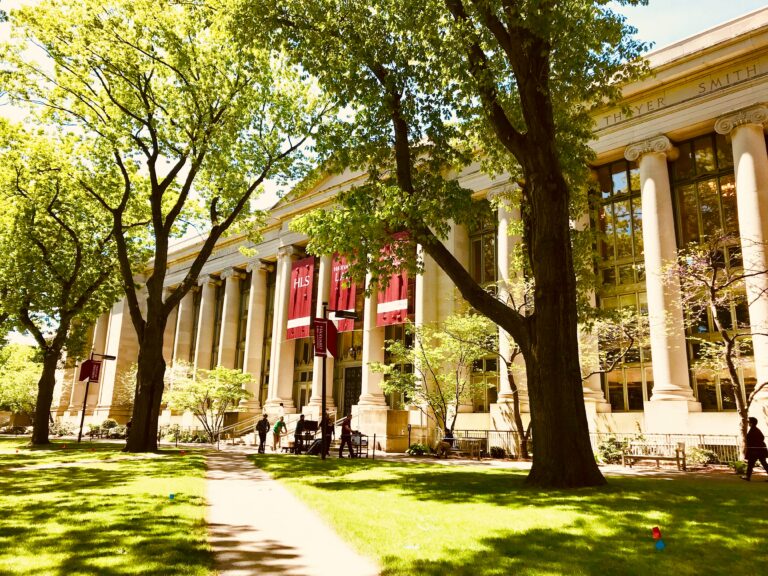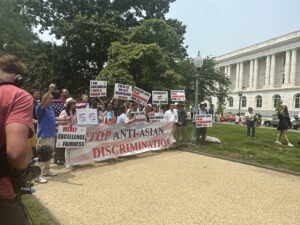Discourse Magazine: The End of Race Preference in College Admissions?

Eliminating race discrimination means eliminating all of it.
So holds the Supreme Court in two consolidated cases handed down yesterday, Students for Fair Admissions v. Harvard and Students for Fair Admissions v. North Carolina. Writing for a six-justice majority, Chief Justice John Roberts answered the simple question at the heart of these cases—may a university make admissions decisions on the basis of race?—with a resounding no.
The Court and Affirmative Action
The line of Supreme Court decisions permitting race-based discrimination in admissions has long been at odds with the rest of the Court’s precedents prohibiting governmental race-based discrimination under the Constitution.
The story starts with Regents of the University of California v. Bakke in 1978. At the time, the University of California’s medical school maintained a two-tier system of admissions, where a specific number of seats were set aside for students from certain racial and ethnic groups. In a fractured 4-1-4 opinion, the Court held that this system was unconstitutional.
Notably, the Bakke majority rejected arguments that race-preferential admissions are permissible if intended to remedy the effects of broad societal discrimination. Such an intention is not the “compelling interest” necessary to render an admissions policy constitutional, but instead presents “an amorphous concept of injury that may be ageless in its reach into the past.” It cannot “justify a [racial] classification that imposes disadvantages on persons . . . who bear no responsibility for whatever harm the beneficiaries of the [race-based] admissions program are thought to have suffered.”
But in a concurrence necessary to secure a controlling majority in Bakke, Justice Lewis Powell said the University of California system was unconstitutional specifically because of its explicit set-asides, in contrast to the more veiled system of racial discrimination Harvard used at the time. According to Powell, Harvard used race, but only as one among many nonacademic factors in a holistic admissions process. Such “flexible” use of race, he stated, would be constitutional.
In another pair of admissions cases in 2003, Grutter v. Bollinger and Gratz v. Bollinger, the Court endorsed and expanded upon Powell’s concurrence and, in the Grutter majority opinion by Justice Sandra Day O’Connor, held that universities may lawfully discriminate in admissions based on race when such discrimination is narrowly tailored to achieve the “educational benefits” of a diverse student body. Later, in two different opinions in Fisher v. University of Texas, the Court clarified that reviewing courts should not defer to a university’s opinion of whether its program is narrowly tailored. In practice, though, that clarification made little difference to universities’ implementation of racial preferences: Nearly all selective universities viewed it as a green light to continue discriminating.
Good Intentions, Bad Results
Justice O’Connor’s majority opinion in Grutter v. Bollinger started to collapse almost immediately under the weight of its internal contradictions. Grutter permitted universities to engage in limited discrimination to achieve the educational benefits of student body diversity, but it also supposedly prohibited universities from stereotyping individuals. But how do you attain those benefits without believing that a Black student is going to bring “Black views”? To avoid the pitfalls associated with such stereotyping, universities had to prefer enough minority students to teach other students that minorities do not all think alike. But then how do you avoid harming other students, including Asians and other minority groups, who are being excluded from admission?
Nearly all selective universities have used race in a manner that makes very little sense if their real goal is student body diversity. Harvard and the University of North Carolina (UNC) are typical of most top colleges: Both use broad racial categories that have such little commonality that they’re virtually meaningless. How does enrolling a Korean American provide the same “benefits of diversity” as enrolling a Pakistani American? The two nations and cultures are vastly different, yet Harvard and UNC treat them as one undifferentiated “Asian” mass. Many other universities—and even the federal government itself—use these broad, stereotyping racial categories that are quite puzzling if the true goal is diversity.
If universities really cared about diversity, they’d design their admissions schemes differently. They would value diversity along nonracial dimensions more, and they would use racial and ethnic categories that better reflect diversity of experience. Instead, most real-world admissions policies seem designed either to rectify historical injustice (a goal the Court has consistently rejected as unlawful) or to implement demographic proportionality for its own sake (also unlawful). As Chief Justice Roberts observed in his majority opinion in the current cases, the universities’ unavailing “main response to these criticisms is, essentially, trust us.”
Justice O’Connor famously aimed to limit Grutter’s reach by saying she expected race preferences to be no longer necessary in 25 years. The twin Students for Fair Admissions cases reached the Court 20 years later, and the students admitted in the next cycle will graduate after Grutter’s 25-year deadline has run. Yet from the universities’ perspective, as the Chief Justice observed, “no end is in sight.” Harvard and UNC both said they anticipated using race indefinitely. And as Justice Clarence Thomas observed in his concurring opinion, race preferences seem to be growing more entrenched over time, not less, at many selective universities.
The majority opinion “today cuts through the kudzu” (as Justice Gorsuch’s concurring opinion puts it) and walks through Grutter’s many points of confusion. Gorsuch concludes that because the two universities lack sufficiently focused and measurable objectives warranting the use of race, unavoidably employ race in a negative manner, involve racial stereotyping and lack meaningful end points, these admissions programs cannot be reconciled with the Equal Protection Clause.
What’s Next?
Although the majority opinion arguably contains a small loophole for the mention of race in students’ admission essays, it also takes pains to keep it plugged. Chief Justice Roberts states that “nothing prohibits universities from considering an applicant’s discussion of how race affected the applicant’s life, so long as that discussion is concretely tied to a quality of character or unique ability that the particular applicant can bring to the university.” But in the very next sentence, the opinion cautions that “universities may not simply establish through application essays or other means the regime that we hold unlawful today” and, citing Cummings v. Missouri, “[W]hat cannot be done directly cannot be done indirectly.” Mindful that the dissent by Justice Sonia Sotomayor suggests this provision as a strategy for circumventing the majority’s opinion, the majority responds archly, “A dissenting opinion is generally not the best source of legal advice on how to comply with the majority opinion.”
What comes next? Some universities have already signaled an intent to circumvent the Students for Fair Admissions holdings, likely via proxy discrimination, or using characteristics that correlate with race so closely that they are basically proxies for race. Southern state and local governments infamously used similar strategies to maintain Jim Crow, such as grandfather clauses, literacy tests and (though it’s now prohibited by constitutional amendment for federal elections) the poll tax. In Village of Arlington Heights v. Metropolitan Housing Development Corp., the Supreme Court developed a test for sussing out such cases of proxy discrimination.
The Supreme Court and lower courts should be prepared to apply the Arlington Heights test for proxy discrimination to identify instances of wrongful discrimination in this novel context. Pacific Legal Foundation’s proxy discrimination cases from K-12 schools offer an example of what rooting out proxy discrimination in universities might look like. The majority opinion’s admonitions are a heartening sign that it is prepared to apply appropriately tough scrutiny.
Individuals should be treated as individuals and not on the basis of the color of their skin. The Students for Fair Admissions opinion is a ringing endorsement of this constitutional, legal and moral principle and deserves to be celebrated accordingly.
This op-ed was originally published at Discourse Magazine on June 30, 2023.











